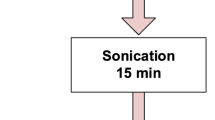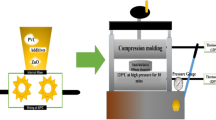Abstract
Nanoparticles distribution techniques inside electrical insulation materials is an essential technology for improving electric and dielectric behavior and maintaining the reliability of industrial applications. In this paper, it has been investigated on dielectric strength of polyvinyl chloride nanocomposites materials based on distribution of individual and multiple nanoparticles techniques under uniform and non-uniform electric fields. It has been succeeded to enhance and control the dielectric strength based on the arrangement of multiple nanoparticles inside polyvinyl chloride materials under uniform and nonuniform applied electric fields. Moreover, optimal types and concentrations of individual and multiple nanoparticles have been specified for dielectric strength degradation under variant thermal conditions (20–80 °C). Trends of using individual and multiple nanoparticles have been depicted the industrial features against traditional industrial materials.










Similar content being viewed by others
References
L. Flandin, L. Vouyovitch, A. Beroual, J.-L. Bessede, N.D. Alberola, Influences of degree of curing and presence of inorganic fillers on the ultimate electrical properties of epoxy-based composites: experiment and simulation. J. Phys. D Appl. Phys. 8(1), 44–55 (2005)
L.A. Dissado, A. Thabet, Simulation of electrical ageing in insulating polymers using a quantitative physical model. J. Phys. D Appl. Phys. 41(8), 1–5 (2008)
L.A. Dissado, A. Thabet, S.J. Dodd, Simulation of DC electrical ageing in insulating polymer films. IEEE Trans. Dielectr. Electr. Insul. 17(3), 896–903 (2010)
T. Tanaka, T. Imai, Advances in nanodielectric materials over the past 50 years. IEEE Electr. Insul. Mag. 29(1), 10–23 (2013)
N.R.R. Royan, A.B. Sulong, J. Sahari, H. Suherman, Effect of acid- and ultraviolet/ozonolysis-treated MWCNTs on the electrical and mechanical properties of epoxy nanocomposites as bipolar plate applications. J. Nanomater. 2013, 1–8 (2013). https://doi.org/10.1155/2013/717459
A.D.G.D. Mauro, A.I. Grimaldi, V.L. Ferrara et al., A simple optical model for the swelling evaluation in polymer nanocomposites. J. Sensors 2009, 1–6 (2009). https://doi.org/10.1155/2009/703206
L. Zhang, J. Zhu, W. Zhou, J. Wang, Y. Wang, Thermal and electrical conductivity enhancement of graphite nanoplatelets on form-stable polyethylene glycol/polymethyl methacrylate composite phase change materials. Energy 39(1), 294–302 (2012)
H. Cong, M. Radosz, B.F. Towler, Y. Shen, Polymer—inorganic nanocomposite membranes for gas separation. Sep. Purif. Technol. 55(3), 281–291 (2007)
L.W. Tang, H.Y. Chien, T.S. Yeong, C.Y. An, W.J. Li, C.Z. Hua, Synthesis of new nanocrystal-polymer nanocomposite as the electron acceptor in polymer bulk heterojunction solar cells. Eur. Polymer J. 46(4), 634–642 (2010)
J. Kaur, J.H. Lee, M.L. Shofner, Influence of polymer matrix crystallinity on nanocomposite morphology and properties. Polymer 52(19), 4337–4344 (2011)
A. Kutvonen, G. Rossi, S.R. Puisto, N.K.J. Rostedt, T.A. Nissila, Influence of nanoparticle size, loading, and shape on themechanical properties of polymer nanocomposites. J. Chem. Phys. 137(21), 1–8 (2012)
W.A. Izzati, Y.Z. Arief, Z. Adzis, Partial discharge characteristics of polymer nanocomposite materials in electrical insulation: a review of sample preparation techniques, analysis methods, potential applications, and future trends. Sci. World J. 2014, 1–14 (2014). https://doi.org/10.1155/2014/735070
A. Krivda et al., Characterization of epoxy microcomposite and nanocomposite materials for power engineering applications. IEEE Electr. Insul. Mag. 28(2), 38–51 (2012)
S. Alapati, M.J. Thomas, Electrical treeing and the associated PD characteristics in LDPE nanocomposites. IEEE Trans. Dielectr. Electr. Insul. 19(2), 697–704 (2012)
T. Tanaka, M. Frechette, G.C. Montanari, T. Tanaka et al., Dielectric properties of XLPE/Si02 nanocomposites based on CIGRE WG DI.24 cooperative test results. IEEE Trans. Dielectr. Electr. Insul. 18(5), 1482–1517 (2011)
Z. Li, K. Okamoto, Y. Ohki, T. Tanaka, The Role of nano and micro particles on partial discharge and breakdown strength in epoxy composites. IEEE Trans. Dielectr. Electr. Insul. 18(3), 675–681 (2011)
T. Lizuka, K. Uchida, T. Tanaka, Voltage endurance characteristics of epoxy/silica nanocomposites. Electron. Commun. 94(12), 65–73 (2011)
L. Zhe, K. Okamoto, Y. Ohki, T. Tanaka, Role of nano-filler on partial discharge resistance and dielectric breakdown strength of micro-A1203/epoxy composites, in IEEE 9th International Conference on the Properties and Applications oj Dielectric Materials, 2009, vol. 1, pp. 753–756
K.Y. Lau, M.A.M. Piah, Polymer nanocomposites in high voltage electrical insulation perspective: a review. Malays. Polymer J. 6(1), 58–69 (2011)
P. Maity, S. Basu, V. Parameswaran, N. Gupta, Degradation of polymer dielectrics with nanometric metal-oxide fillers due to surface discharges. IEEE Trans. Dielectr. Electr. Insul. 15(1), 52–62 (2008)
T. Tanaka, Dielectric nanocomposites with insulating properties. IEEE Trans. Dielectr. Electr. Insul. 12(5), 914–928 (2005)
T. Tanaka, G.C. Montanari, R. Mulhaupt, Polymer nanocomposites as dielectrics and electrical insulation-perspectives for processing technologies, material characterization and future applications. IEEE Trans. Dielectr. Electr. Insul. 11(5), 763–784 (2004)
A. Thabet, Experimental enhancement for dielectric strength of polyethylene insulation materials using cost-fewer nanoparticles. Int. J. Electr. Power Energy Syst. (IJEPES) 64, 469–475 (2015). https://doi.org/10.1016/j.ijepes.2014.06.075
A. Thabet, Y.A. Mubarak, Experimental dielectric measurements for cost-fewer polyvinyl chloride nanocomposites. Int. J. Electr. Comput. Eng. (IJECE) 5(1), 13–22 (2015)
A. Thabet, Thermal experimental verification on effects of nanoparticles for enhancing electric and dielectric performance of polyvinyl chloride. J. Int. Meas. Confed. (IMEKO) 89, 28–33 (2016). https://doi.org/10.1016/j.measurement.2016.04.002
A.A. Ebnalwaled, A. Thabet, Controlling the optical constants of PVC nanocomposite films for optoelectronic applications. Synth. Metals J. 220, 374–383 (2016). https://doi.org/10.1016/j.synthmet.2016.07.006
A. Thabet, Experimental control of dielectric loss behavior of polyvinyl chloride nanocomposites under thermal conditions, in IEEE, International Middle East Power System Conference “MEPCON”, 19–21 Dec, Menofia, EGYPT, 2017, vol. 1, pp. 12–17
A. Thabet, Theoretical analysis for effects of nanoparticles on dielectric characterization of electrical industrial materials. Electr. Eng. ELEN J. 99(2), 487–493 (2017)
A. Thabet, Y.A. Mubarak, The effect of cost-fewer nanoparticles on the electrical properties of polyvinyl chloride. Electr. Eng. J. 99(2), 625–631 (2017)
A. Thabet, A.A. Ebnalwaled, Improvement of surface energy properties of PVC nanocomposites for enhancing electrical applications. IMEKO 110, 78–83 (2017). https://doi.org/10.1016/j.measurement.2017.06.023
A. Thabet, Y.A. Mobarak, Experimental study for dielectric strength of new nanocomposite polyethylene industrial materials. Int. J. Electr. Eng. Technol. (IJEET) 3(1), 353–364 (2012)
A. Thabet, Experimental verification for improving dielectric strength of polymers by using clay nanoparticles. Adv. Electr. Electron. Eng. J. 13(2), 182–190 (2015)
O. Gouda, Y.A. Mobarak, M. Samir, A simulation model for calculating the dielectric properties of nano-composite materials and comprehensive interphase approach, in 14th International Middle East Power Systems Conference (MEPCON), Cairo University, Egypt, 2010, vol. 1, pp. 151–156
K.K. Karkkainen, A.H. Sihvola, K.I. Nikoskinen, Effective permittivity of mixtures: numerical validation by the FDTD method. IEEE Trans. Geosci. Remote Sens. 38(3), 1303–1308 (2000)
M. Todd, F. Shi, Molecular basis of the interphase dielectric properties of microelectronic and optoelectronic packaging materials. IEEE Trans. Compon. Packag. Technol. 26(3), 667–672 (2003)
A. Thabet, N. Salem, Optimizing dielectric characteristics of electrical materials using multi-nanoparticles technique, IEEE, International Middle East Power System Conference “MEPCON”, 19–21 Dec, Menofia, EGYPT, 2017, vol. 1, pp. 220–225
G. Polizos, E. Tuncer, I. Sauers, K.L. More, Properties of a nanodielectric cryogenic resin. Appl. Phys. Lett. 96(15), 152903–152903-3 (2010)
N. Tagami, M. Hyuga, Y. Ohki, T. Tanaka et al., Comparison of dielectric properties between epoxy composites with nanosized clay fillers modified by primary amine and tertiary amine. IEEE Trans. Dielectr. Electr. Insul. 17(1), 214–220 (2010)
M. Todd, F. Shi, Characterizing the interphase dielectric constant of polymer composite materials: effect of chemical coupling agents. J. Appl. Phys. 94(7), 4551–4557 (2003)
Y. Yi, M. Sastry, Analytical approximation of the twodimensional percolation threshold for fields of overlapping ellipses. Phys. Rev. E 66(6), 066130-1–066130-8 (2002)
C.J. Brinker, G.W. Scherer, Sol-Gel Science: The Physics Chemistry of Sol-Gel Processing, An Imprint of Elsevier (Academic Press, Inc., Cambridge, 1990). ISBN 0-12-134970-5
L. Bois, F. Chassagneux, S. Parola, F. Bessueille, Growth of ordered silver nanoparticles in silica film mesostructured with a triblock copolymer PEO–PPO–PEO. J. Solid State Chem. 182(7), 1700–1707 (2009)
H.N. Azlinaa, J.N. Hasnidawania, H. Norita, S.N. Surip, Synthesis of SiO2 nanostructures using sol-gel method, in 5th International Science Congress & Exhibition APMAS2015, Lykia, Oludeniz, 16–19 April, vol. 129(1) (2016), pp. 842–844
B. Reddy, Advances in Nanocomposites—Synthesis, Characterization and Industrial Applications (Intech Open, London, 2011), pp. 323–340. ISBN 978-953-307-165-7
Acknowledgements
The present work was supported by Nanotechnology Research Center at Aswan University that is established by aided the Science and Technology Development Fund (STDF), Egypt, Grant No. Project ID 505, 2009–2011.
Author information
Authors and Affiliations
Corresponding author
Additional information
Publisher's Note
Springer Nature remains neutral with regard to jurisdictional claims in published maps and institutional affiliations.
Rights and permissions
About this article
Cite this article
Thabet, A., Salem, N. Experimental Verification on Dielectric Breakdown Strength Using Individual and Multiple Nanoparticles in Polyvinyl Chloride. Trans. Electr. Electron. Mater. 21, 274–282 (2020). https://doi.org/10.1007/s42341-020-00176-1
Received:
Revised:
Accepted:
Published:
Issue Date:
DOI: https://doi.org/10.1007/s42341-020-00176-1




